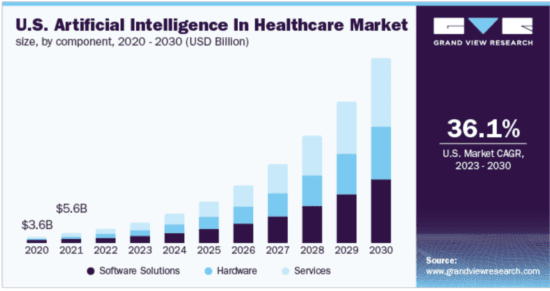Given all of the hype around AI these days, it seems like you can’t miss as an investor if you allocate significant capital into any company with AI in its name. In spite of the significant downturn in public and private markets over the last 18 months, one category that has resisted the sharp downturn to a degree has been AI. That is party due to the fact that many people see its enormous capabilities and think that its adoption is inevitable over the next few years. The penetration of AI applications across the different sectors of the economy is rather low right now and it’s even lower in healthcare.
There are many reasons for healthcare always being a laggard when it comes to the adoption of digital technologies. Digital by its nature needs data to provide its output and healthcare data is very sensitive. As such, it’s hard to get a hold of that data to build good digital solutions and also have it available on an ongoing basis when you put your solution into production. Healthcare data is fragmented, usually full of mistakes, and not standardized. So, that will delay the penetration of AI technologies in healthcare. However, the potential applications in healthcare are immense and their adoption will be coming. So, how do you decide when to invest and what to invest in?
Over the last 3 years that I’ve been researching this topic while writing my upcoming book, AI Doctor: The Rise of Artificial Intelligence in healthcare, I’ve developed a framework for thinking about the upcoming adoption of AI in healthcare. This framework is based on the idea that there will be several waves of adoption of these technologies by the various players in healthcare. These waves will be a function of the economic value of the technology to the buyers (e.g. health systems, insurance companies, or life science companies) availability of all of the data needed for the system to perform its desired function (not easy to have complete data flow into the system in a reliable manner!) readiness of the existing IT systems to interface with the new AI solution, and workflows that can accommodate or be transformed with these solutions. If any of these factors are not satisfied, you can safely assume that the short-term adoption will be unlikely.
The decision makers at the buying organizations are being bombarded with companies pitching them new technologies for research, clinical, and administrative use cases. There is not possibly enough money for even a fraction of these. To start with, much of the IT dollars at these institutions go to maintaining the current systems in place (e.g., EHRs, data warehouse, etc) and thus the budget for innovative solutions is what is left over after the essentials are taken care of. This means that each group within the organization pursuing the purchase of an innovative AI technology will need to make their case to the decision makers.
The decision makers are often from different parts of the organizations and may have competing priorities. A chief medical officer represents the interests of the physicians and consider the benefits to their workflows. The chief technology officer will be concerned with adding yet another application to the technology stack in the organization and how that might impact all of the other technologies. Often, these IT organizations are under-staffed and not excited about onboarding too many new applications. The business leadership will worry about the revenue and cost implications, whether there will be reimbursement for the new application, and if the overall economic benefits to the organizations will be more than the other twenty applications on their desk.
As you can see, this is not for the faint of heart. Over the next few posts, we can dig deeper into the analysis that can help an investor decide if a health AI company is checking the right boxes to be worth issuing a Term Sheet to.






